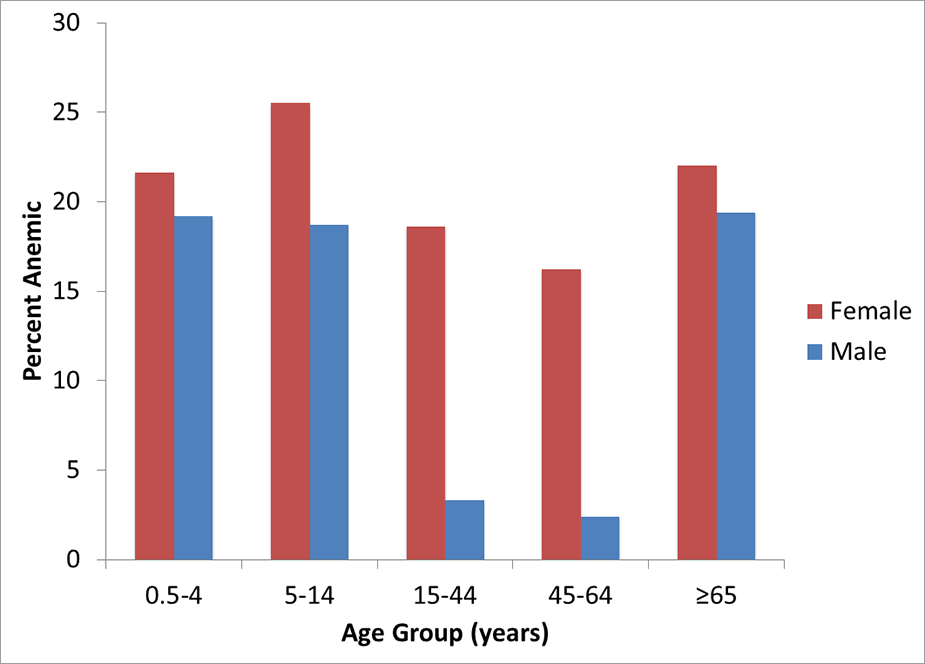Nutrition
Bhutanese Refugee Health Profile
Anemia
Anemia is a common condition among Bhutanese refugees, reflecting global rates among people of a similar age and gender. 17 Approximately 20% of children under 15 as well as 20% of refugees aged 65 and older were anemic upon arrival in Texas in June 2009–May 2011 (Figure 8). 15 The prevalence of anemia in women of reproductive age is approximately 19% while pregnant women have an anemia prevalence of 28%. 15 The most common cause of anemia is due to iron deficiency but a number of other conditions affecting Bhutanese refugees could play a contributory role, including malaria, intestinal parasites, deficiencies of vitamin B12 and other micronutrients, tuberculosis, hemoglobinopathies, and chronic disease. According to another survey administered to refugee children aged 6-59 months and their mothers in Nepali refugee camps in 2007, anemia was detected in 13.6% of mothers and 43.3% of children and decreased with age in children. 11
Figure 8: Anemia found in Bhutanese refugees during post-arrival screening examinations in one large resettlement state, June 2009–May 2011

Malnutrition
Limited food diversity, frequent illness, and feeding practices have been identified as underlying causes of malnutrition in the Bhutanese refugee population. 11 In 2007, acute malnutrition (i.e., wasting) was found in 4.2% of Bhutanese children aged 6–59 months living in camps in Nepal while chronic malnutrition (i.e., stunting) was found in 26.9% of children. 11 Similar rates of acute and chronic malnutrition were detected in Bhutanese refugee children resettling in Texas from 2008–2011 (5.7% and 22.8%, respectively). 15
Micronutrient Deficiencies
In addition to iron deficiency anemia, other micronutrient deficiencies have been identified among Bhutanese refugees. Vitamin B12 deficiency, a rare condition in the United States, was found in approximately 30-60% of Bhutanese refugees who resettled to the United States during 2008–2011 in an investigation conducted by CDC. 18 This high proportion was likely due to a lack of vitamin B12 in their diet in refugee camps in Nepal. Vitamin B12 deficiency can result in megaloblastic anemia, peripheral neuropathy, and other potentially permanent neurologic signs. All Bhutanese refugees should be given nutritional advice and should receive supplemental vitamin B12 upon arrival in the U.S. Other micronutrient deficiencies, including vitamin B2 (riboflavin), which results in high rates of angular stomatitis in adolescents, have been identified in this population. 19 A survey conducted in 1999 demonstrated vitamin A deficiency in 30% of Bhutanese refugee adolescents. 20
Obesity
The prevalence of obesity in Bhutanese refugees (defined as BMI >30 kg/m2 in adults > 15 years old or BMI > 95% in children 5–14 years of age), is much lower than that seen in the US population. 16 Obesity was observed in the following proportions of Bhutanese refugees screened in Texas from 2008-2011:
- 5-14 years: 2.1%
- > 15 years: 5.7%
References
- Centers for Disease Control and Prevention (CDC). Malnutrition and micronutrient deficiencies among Bhutanese refugee children—Nepal, 2007. MMWR Morb Mortal Wkly Rep. 2008 Apr 11;57(14):370-3.
- Texas Department of State Health Services (2009-2011), Electronic System for Health Assesment of Refugees (eShare Database).
- National Center for Health Statistics (2011). Health, United States, 2010: With special feature on death and dying. Hyattsville, MD.
- Worldwide prevalence of anaemia (1993–2005): WHO global database on anaemia / Edited by Bruno de Benoist, Erin McLean, Ines Egli and Mary Cogswell.
- Centers for Disease Control and Prevention (CDC). Vitamin B12 deficiency in resettled Bhutanese refugees—United States, 2008-2011. MMWR Morb Mortal Wkly Rep. 2011 Mar 25;60(11):343-6.
- Blanck HM, Bowman BA, Serdula MK, Khan LK, Kohn W, Woodruff BA; Bhutanese Refugee Investigation Group. Angular stomatitis and riboflavin status among adolescent Bhutanese refugees living in southeastern Nepal. Am J Clin Nutr 2002;76:430–5.
- Woodruff, BA, Blanck HM, Slutsker L, Cooksoon ST, Larson MK, Duffield A, Bhatia R. Anaemia, iron status and vitamin A deficiency among adolescent refugees in Kenya and Nepal. Public Health Nutr. 2006 Feb;9(1), 26–34.
- Page last reviewed: June 22, 2012
- Page last updated: February 24, 2014
- Content source:


 ShareCompartir
ShareCompartir